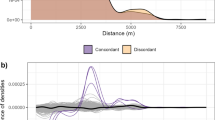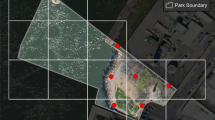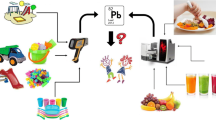Abstract
High-precision lead isotope ratios and lead concentrations have been compared statistically and graphically in women of child-bearing age (n = 77) from two smelter communities and one general urban community to evaluate the relative contributions to blood lead of tissue lead stores and lead from the contemporaneous environment (soil, floor dust, indoor airborne dust, water, food). Blood lead (PbB) contents were generally low (e.g. <10 μg dL−1). Statistically significant isotopic differences in blood and environmental samples were observed between the three cities although isotopic differences in blood for individual subjects living in close proximity (∼200 m radius) was as large as the differences within a city. No single environmental measure dominated the biological isotope profile and in many cases the low levels of blood lead meant that their isotopic profiles could be easily perturbed by relatively small changes of environmental exposure. Apportioning of sources using lead isotopes is possibly not feasible, nor cost effective, when blood lead levels are <5 μg dL−1. Interpretations based on statistical analyses of city-wide data do not give the same conclusions as when the houses are considered individually. Aggregating data from multiple subjects in a study such as this obscures potentially useful information. Most of the measures employed in this study, and many other similar studies, are markers of only short-to-medium integration of lead exposure. Serial sampling of blood and longer sampling times, especially for household variables, should provide more meaningful information.
Similar content being viewed by others
References
Body, P.E., Inglis, G.R. and Mulcahy, D.E. 1988.Lead Contamination in Port Pirie South Australia. SA Department of Environment and Planning, Adelaide.
Bornschein, R.L., Clark, C.S., Grote, J., Peace, B., Roda, S. and Succop, P. 1989. Soil lead-blood lead relationship in a former lead mining town.Environmental Geochemistry and Health,9, 149–160.
Brown, K.W., Mullins, J.W., Richitt, E.P., Flatman, G.T., Black, S.C. and Simon, S.J. 1985. Assessing soil lead contamination in Dallas, Texas.Environmental Monitoring and Assessment,5, 137–154.
Clark, S., Bornschein, R.L., Succop, P., Peace, B., Ryan, J. and Kochanowski, A. 1989. The Cincinnati soil-lead abatement demonstration project.Environmental Geochemistry and Health,9, 287–300.
Eylenbosch, W.J., von Sprundel, M.P. and Clara, R.R. 1984. Lead Pollution in Antwerpen, Belgium.Annals Acadam. Medicine,13, 224–230.
Faccheti, S. 1989. Lead in petrol. The isotopic lead experiment.Acc. hem. Res.,22, 370–374.
Faure, G. 1986.Principles of Isotope Geology. John Wiley and Sons, New York, p. 589.
Gulson, B.L. 1986. Lead Isotopes in Mineral Exploration. Elsevier, Amsterdam, p. 245.
Landrigan, P.J., Gehlbach, S.H., Rosenblum, B.F., Shoults, J.M., Candelariia, R.M., Barthel, W.F., Liddle, J.A., Smrek, A.L., Staehling, N.W. and Sanders, J.F. 1975. Epidemic lead absorption near an ore smelter.New England Journal of Medicine,292, 123–129.
Landrigan, P.J., Baker, E.L., Feldman, R.G., Cox, D.H., Eden, K.V., Orenstein, W.A., Mather, J.A., Yankel, A.J. and von Lindern, I.H. 1976. Increased lead absorption with anemia and slowed nerve conduction in children near a lead smelter.Journal of Pediatrics,89, 904–910.
Manton, W.I. 1977. Sources of lead in blood: identification by stable isotopes.Archives of Environmental Health,32, 149–157.
Manton, W.I. 1985. Total contribution of airborne lead to blood lead.British Journal of Industrial Medicine,42, 168–172.
Maravelias, C., Hatzakis, A., Katsouyanni, K., Trichopoulos, D., Koutselinis, A., Ewers, U. and Brockhauss, A. 1989. Exposure to lead and cadmium of children living near a lead smelter at Lavrion, Greece.Science of the Total Environment,84, 61–70.
Prpic-Majic, D., Meczner, J., Telisman, S. and Kersanic, A. 1984. Biological monitoring of lead effects in a smelter community before and after emission control.Science of the Total Environment,32, 277–288.
Rabinowitz, M.B. 1987. Stable isotope mass spectrometry in childhood lead poisoning.Biological and Trace Element Research,12, 223–229.
Rabinowitz, M.B. and Bellinger, D.C. 1988. Soil lead-blood lead relationship among Boston children.Bulletin of Environmental Contamination and Toxicology,41, 791–797.
Roels, H.A., Buchet, J., Lauwerys, R.R., Bruaux, P., Claeys-Thoreau, F., Lafontaine, A. and Verduyn, G. 1980. Exposure to lead by the oral and pulmonary routes of children living in the vicinity of a primary lead smelters.Environmental Research,22, 81–94.
Silbergeld, E.K., Schwartz, J. and Mahaffey, K.R. 1988. Lead and osteoporosis: mobilisation of lead from bone in postmenopausal women.Environmental Research,47, 79–94.
Silvany-Neto, A.M., Carvalho, F.M., Chaves, M.E.C., Brandao, A.M. and Tavares, T.M. 1989. Repeated surveillance of lead poisoning among children.Science of the Total Environment,78, 179–186.
Tera, O., Schwartzman, D.W. and Watkins, T.R. 1985. Identification of gasoline lead in children's blood using isotopic analysis.Archives of Environmental Health,40, 120–123.
Yaffe, Y., Flessel, C.P., Wesolowski, J.J., Rosario, A.D., Giurguis, G.N., Matias, V., Degarmo, T.E., Coleman, G.C., Gramlich, J.W. and Kelly, W.R. 1983. Identification of lead sources in Californian children using the stable isotope ratio technique.Archives of Environmental Health,38, 237–245.
Tiller, K.G., Merry, R.H., Cartwright, B. and Bartlett, N.R. 1975. Dispersal of lead emissions from an isolated lead smelter within an agricultural region of South Australia.Search,6, 437–438.
Tiller, K.G. and de Vries, M.C. 1977. Contamination of soils and vegetables near the lead-zinc smelter, Port Pirie by cadmium, lead and zinc.Search,8, 78–79.
US Geological Survey. 1976.Lead in the Environment. Professional Paper No. 957. Washington, D.C.
Walter, S.D., Yankel, A.J. and von Lindern, I.H. 1980. Age-specific risk factors for lead absorption in children.Archives of Environmental Health,35, 53–58.
Yankel, A.J., von Lindern, I.M. and Walter, S.D. 1977. The Silver Valley Lead Study: the relationship between childhood blood lead levels and environmental exposure.Journal of Air Pollution Control Association,27, 763–767.
Author information
Authors and Affiliations
Rights and permissions
About this article
Cite this article
Gulson, B.L., Pisaniello, D., McMichael, A.J. et al. Stable lead isotope profiles in smelter and general urban communities: a comparison of environmental and blood measures. Environ Geochem Health 18, 147–163 (1996). https://doi.org/10.1007/BF01771238
Received:
Accepted:
Issue Date:
DOI: https://doi.org/10.1007/BF01771238




